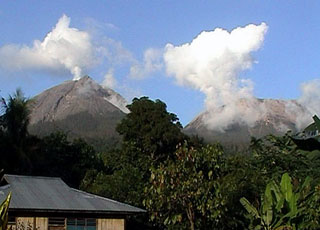Report on Lewotobi (Indonesia) — July 1999
Bulletin of the Global Volcanism Network, vol. 24, no. 7 (July 1999)
Managing Editor: Richard Wunderman.
Lewotobi (Indonesia) 1 July explosion ignites fires and up to 1 mm of ash falls on local villages
Please cite this report as:
Global Volcanism Program, 1999. Report on Lewotobi (Indonesia) (Wunderman, R., ed.). Bulletin of the Global Volcanism Network, 24:7. Smithsonian Institution. https://doi.org/10.5479/si.GVP.BGVN199907-264180
Lewotobi
Indonesia
8.542°S, 122.775°E; summit elev. 1703 m
All times are local (unless otherwise noted)
Lewotobi Laki-Laki erupted at 1000 on 1 July. A strong blast accompanied the eruption. Glowing material fell in a 500 m radius to the N and S, igniting forest fires that extended 2.5 km N of the crater and 500 m S, to the ridge dividing Lewotobi Laki-Laki from Lewotobi Perempuan. Ash emissions reached 1,000 m above the summit and were distributed to the W, SW, and S. The emissions then drifted to the NW, W, SW, and S in an 8-km radius. The settlements of Boru, Bawalatang, and Watukubu reported ash deposits in the range 0.5-1 mm thick.
"White, thin-to-thick ash emissions" have continued since the initial eruption, rising ~100 m above the summit. Authorities raised the volcano status to "Level III" (prepare to evacuate) on 2 July. The seismic record for the week 29 June to 5 July reported 266 type-A, 70 type-B, two tectonic, and 31 explosive events.
Geological Summary. The Lewotobi edifice in eastern Flores Island is composed of the two adjacent Lewotobi Laki-laki and Lewotobi Perempuan stratovolcanoes (the "husband and wife"). Their summits are less than 2 km apart along a NW-SE line. The conical Laki-laki to the NW has been frequently active during the 19th and 20th centuries, while the taller and broader Perempuan has had observed eruptions in 1921 and 1935. Small lava domes have grown during the 20th century in both of the summit craters, which are open to the north. A prominent cone, Iliwokar, occurs on the E flank of Perampuan.
Information Contacts: R. Sukhyar and Dali Ahmad, Volcanological Survey of Indonesia (VSI), Jalan Diponegoro No. 57, Bandung 40122, Indonesia (URL: http://www.vsi.esdm.go.id/).

